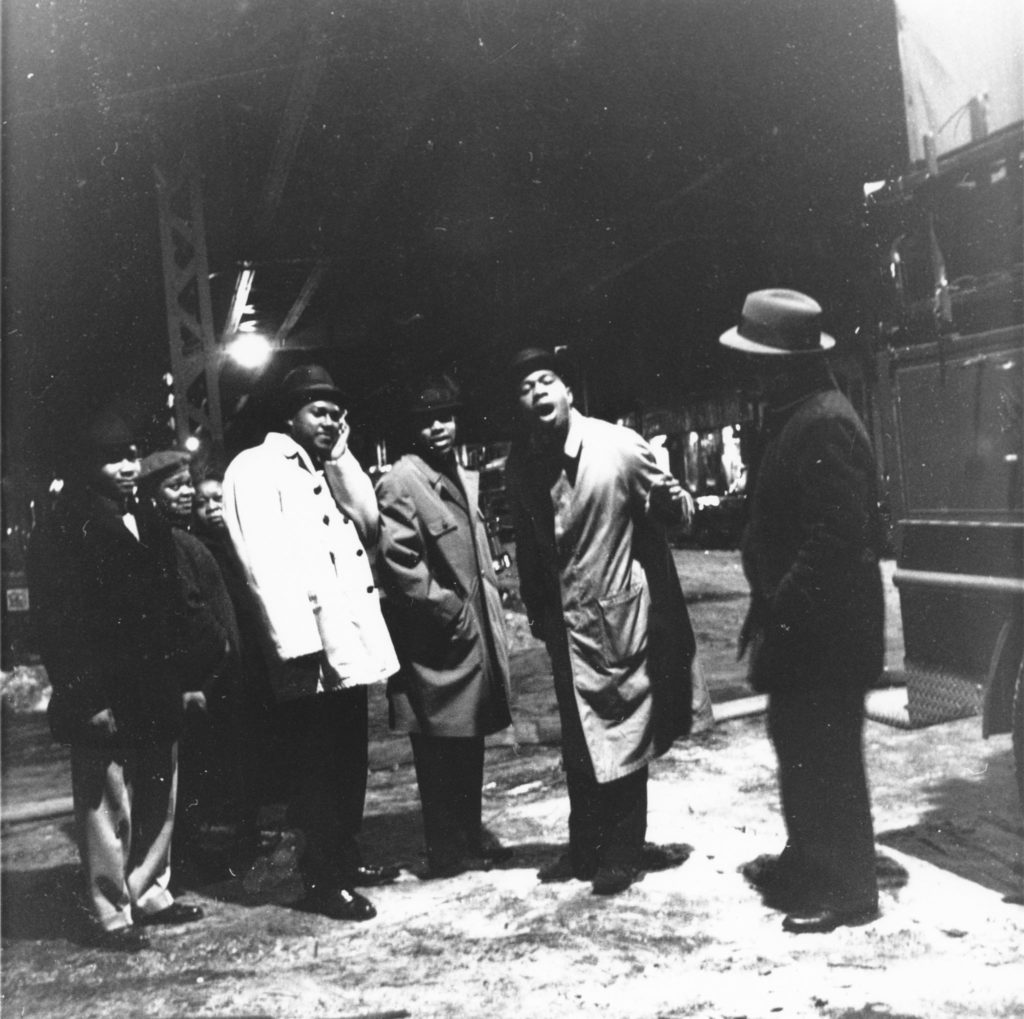Doo Wop: Black (Music) In the Greene – Part 1
 In her memoir, African American activist and former Black Panther party member, Assata Shakur, recalls a Brooklyn night in the early 1960s when she attended a party hosted by the warlords of the Fort Greene Chaplins, a black gang that once ruled the Walt Whitman & Raymond Ingersoll Houses (originally known as the Fort Greene Projects), once described in the New York Times as a place where “nowhere this side of Moscow are you likely to find public housing so closely duplicating the squalor it was designed to supplant.” In those days (roughly the post-war era of the 1950s and early 1960s) it was typical to read in the tabloids that a youth had been “stabbed near the Navy Yard” or “stomped to death in an argument over a dime”. Gangs with sinister noms-de-guerre like the Chaplains, the Mau-Maus and the Fort Greene Stompers blinded each other with a mixture of Red Devil lye and Pepsi-Cola and hurled each other from rooftops.
In her memoir, African American activist and former Black Panther party member, Assata Shakur, recalls a Brooklyn night in the early 1960s when she attended a party hosted by the warlords of the Fort Greene Chaplins, a black gang that once ruled the Walt Whitman & Raymond Ingersoll Houses (originally known as the Fort Greene Projects), once described in the New York Times as a place where “nowhere this side of Moscow are you likely to find public housing so closely duplicating the squalor it was designed to supplant.” In those days (roughly the post-war era of the 1950s and early 1960s) it was typical to read in the tabloids that a youth had been “stabbed near the Navy Yard” or “stomped to death in an argument over a dime”. Gangs with sinister noms-de-guerre like the Chaplains, the Mau-Maus and the Fort Greene Stompers blinded each other with a mixture of Red Devil lye and Pepsi-Cola and hurled each other from rooftops.
Still, Shakur recalls her evening of eating French fries, drinking Thunderbird and wine, smoking cigarettes in the hallway and dancing the night away, as “romantic”. “The music was playing and the lights were down low…” she writes, “and I was feeling gooooooood.” In other words, Fort Greene may have been bleak but it was also bliss; a place for style and street cred. Birds (a late 1950s early 1960s slang word for teenaged girls) wore mile high bouffant hairdos, jet black eyeliner, and tiny stacked cuban-heeled Voodoo shoes and hep cats (a slang word for teenaged boys) bopped in tight-crotch pants and stocking caps pressed down over close cropped waves. In an era of economic strain and unrest, the times were tough and the area was tougher. Brooklyn was also THE destination for great black music. All kinds of music.
DOO WOP, ROCK ‘N ROLL, MOTOWN & MORE
The Fort Greene Housing Projects would give birth to doo-wop singer Little Anthony Gourdine (of Little Anthony and the Imperials), rapper Dana Dane, MCs Just-Ice and ODB, R&B singer/songwriter Lisa Fischer and Grammy-award winning gospel music artist Hezekiah Walker and many others. Fort Greene, Clinton Hill and downtown Brooklyn, had established itself as a destination for great Black music long before that.
During the height of the jazz age, in 1928, the Brooklyn Paramount Theater opened its doors at the corner of Flatbush and DeKalb avenues, boasting a a 2,000 pipe, 257 stops Wurlitzer organ (second only in size to the behemoth at Radio City Music Hall). The ornate rococo interior designed theater was a magnificent 4,124 seat movie palace. Well into 1960s, the theater (and surrounding area) remained a destination for great live music, introducing Brooklyn to rock n- roll.
In the 1950s, radio DJ Alan Freed’s rock-n-roll shows played at the theater, with acts including Chuck Berry and Fats Domino (later, after concern over teenage rioting, the shows were moved to the Brooklyn Fox Theater, on Flatbush and Nevins. At the height of the rock n’ roll era, artists including Chuck Berry, Fats Domino, the Ronettes, Ben E. King, Smokey Robinson & the Miracles, Marvin Gaye, the Temptations, the Four Tops, Mary Wells, Dionne Warwick, Patti Labelle & the Bluebelles, the Spinners, the O’Jays, the Marvelettes, Chubby Checker, the Shirelles, Jackie Wilson, Johnny Mathis, Etta James, the Isley Brothers, Bo Diddley and the Flamingos all played either the Fox or the Paramount.
When Alan Freed fell victim to the payola scandal of the 1960s, TV host Clay Cole continued his ten-day holiday show tradition, in 1964 featuring a Motown revue with Marvin Gaye, the Miracles, the Marvelettes, Stevie Wonder, the Temptations and the Supremes, breaking all existing attendance records. Cole would also present other acts at the Fox, including, Ray Charles, Bo Diddley, and Little Anthony & The Imperials.
SHOWTIME AT THE PARAMOUNT
According to anthropology professor Michael Hittman, “there were five shows a day noon through midnight” at the Brooklyn Paramount, each show preceded by a B movie. Rock musician/songwriter Peter Sando recalls the shows “would run for ten days” with line forming half around the block as early as 3:30 a.m. Mounted police were called in and barricades erected to the teenagers to the sidewalks. Hittman writes, “It was a strange scene in the twilight, all these kids, black, white, Hispanic, all with a common thread binding them together, the Music! And everybody was there–all the Rock and Roll stars–sometimes over 20 acts in a show! All for $2.50… every act came out and did their two or three best hits and went right off leaving the crowd dying for more.”
With the erection of more modern concert stages, elaborate dinosaurs like the Paramount and the Fox Theater were simply outmoded. The Paramount was shuttered in 1960 and converted two years later into its current use as a gymnasium for Long Island University’s Brooklyn Campus (the world famous organ and some of the original rococo arches remain). On Thursday, February 3, 1968, the $8 Million Fox Theater went dark and its imminent demolition followed soon after. Nevertheless, in the post-Vietnam war era, Fort Greene and Clinton Hill would soon rise again as a destination for great Black music.
Read more stories about local Black history in Fort Greene, by guest contributor Carl Hancock Rux, by clicking here.

